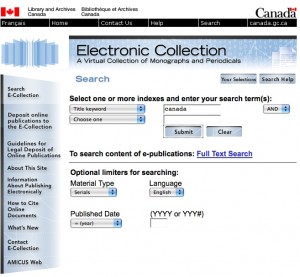Thursday, July 9, 2009 @9:30
SFU Harbour Centre (Sauder Industries Rm 2270)
Presenters:
Pam Armstrong (Manager of the Digital Preservation Office at Library and Archives Canada and Business Lead of the LAC Trusted Digital Repository Project)
Susan Haigh (Manager of the Digital Office of Published Heritage at Library and Archives Canada)
Session Overview
Pam Armstrong and Susan Haigh succinctly present the aims of and current progress of Library and Archives Canada’s Trusted Digital Repository and Legal Deposit.
Commentary
Pam Armstrong reviewed the Library and Archives Canada (“LAC”) Trusted Digital Repository (“TDR”) project currently underway. Two key aspects of the project were identified as the building component (of the necessary infrastructure) and the business component (the workflow and efficiencies associated with it). Current projects with the TDR include creating a digital format registry, establishing threat risk assessment, establishing effective communications strategies and establishing a storage policy for data. Armstrong points to collaboration as the key to facing the challenges of preserving the digital heritage of Canadians which, given the amount of collaborators involved, is crucial in ensuring the integrity of preservation. Additionally, Armstrong suggests that the TDR brings a corporate approach to digital preservation due to the requirement of having content providers register online. The logistics of the TDR are displayed in a framework illustrating the structured flow of data. Data goes through a quarantine zone then to a virtual loading dock (where it is, among other things, scanned for viruses, decrypted and validated) then to staff processing (where metadata is enhanced) then in to a metadata management system and finally to an access zone. Ultimately, it appears that the TDR will not only organize and preserve data but it will also make it more accessible to Canadians through the world wide web.
Susan Haigh reviewed the mandates of the Library and Archives Canada Act and broke down the logistics of the Virtual Loading Dock (“VLD”) that exists within the Legal Deposit side of the electronic collections. Haigh highlighted the LAC mandate as the preservation of documentary heritage of Canadians through acquisition and preservation of publications at any cost. She identifies the VLD as an effective tool to do so that requires publishers to adhere to a law obliging them to deposit two copies of a publication and its contents in cryptic form along with any metadata in the VLD. This puts the onus of responsibility on the publisher, though Haigh forwards this with “theoretically” indicating that it is not yet as streamlined as it could be. Simply put, the VLD is part of a drive to build an accessible and comprehensible electronic collection. As a result of this collaborative effort since 1994, there are over 60,000 titles (monographs, serials and websites) and over 150,000 journal issues housed in the Legal Deposit. Open source software is called up in LAC projects including Heritrix, an open source archival software, which is used to acquire domains associated with the federal, provincial and territorial governments as well as Olympic Games domains.

- Front page of LAC’s Electronic Collection
The VLD was conceived as a pilot project in an effort to make the electronic collections at LAC more efficient. This software-based approach had several aims including to test methodologies and to learn technical and operational details about the workflow related to the intake of electronic materials of various types. As is the nature of a pilot project, LAC learned many lessons about the VLD that will ensure adjustments will be made in the future to make archival of materials even more efficient. Lessons learned include the need for distinct ISBN’s for digital editions, the need to have the bugs worked out of JHOVE with respect to large PDF files and a need to tweak the functionality for publisher registration. Haigh indicated that this first release of the VLD was very useful in raising an understanding of the importance of functionality for metadata capture by making sure it is efficient and clear to publishers.
Moving to the future, LAC will begin to test serials as well as all transfer methods associated with the Legal Deposit. Additionally, LAC will explore two important questions related to preservation:
1. How do we capture Canadian OJS journals for legal deposit and preservation purposes?
2. How can LAC and the Can OJS community collaborate?
As for access, it is clear that the goal of the TDR is to provide access but I would be interested to see statistics regarding who is actually accessing the materials from the LAC (ie. mostly the academic community or individuals for personal purposes). In keeping within the confines of copyright, Armstrong notes that rights associated with content as dictated by the publisher will be reflected in terms of access.
Related Links
Library and Archives Canada – Official Site
Library and Archives Canada Act
Library and Archives Canada – Trusted Digital Repository Project
Library and Archives Canada – Legal Deposit
Library and Archives Canada – Electronic Collection
Article – “Attributes of a Trusted Digital Repository: Meeting the Needs of Research Resources”